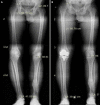Single-center experience with Knee+™ augmented reality navigation system in primary total knee arthroplasty
- PMID: 38596188
- PMCID: PMC10999969
- DOI: 10.5312/wjo.v15.i3.247
Single-center experience with Knee+™ augmented reality navigation system in primary total knee arthroplasty
Abstract
Background: Computer-assisted systems obtained an increased interest in orthopaedic surgery over the last years, as they enhance precision compared to conventional hardware. The expansion of computer assistance is evolving with the employment of augmented reality. Yet, the accuracy of augmented reality navigation systems has not been determined.
Aim: To examine the accuracy of component alignment and restoration of the affected limb's mechanical axis in primary total knee arthroplasty (TKA), utilizing an augmented reality navigation system and to assess whether such systems are conspicuously fruitful for an accomplished knee surgeon.
Methods: From May 2021 to December 2021, 30 patients, 25 women and five men, underwent a primary unilateral TKA. Revision cases were excluded. A preoperative radiographic procedure was performed to evaluate the limb's axial alignment. All patients were operated on by the same team, without a tourniquet, utilizing three distinct prostheses with the assistance of the Knee+™ augmented reality navigation system in every operation. Postoperatively, the same radiographic exam protocol was executed to evaluate the implants' position, orientation and coronal plane alignment. We recorded measurements in 3 stages regarding femoral varus and flexion, tibial varus and posterior slope. Firstly, the expected values from the Augmented Reality system were documented. Then we calculated the same values after each cut and finally, the same measurements were recorded radiologically after the operations. Concerning statistical analysis, Lin's concordance correlation coefficient was estimated, while Wilcoxon Signed Rank Test was performed when needed.
Results: A statistically significant difference was observed regarding mean expected values and radiographic measurements for femoral flexion measurements only (Z score = 2.67, P value = 0.01). Nonetheless, this difference was statistically significantly lower than 1 degree (Z score = -4.21, P value < 0.01). In terms of discrepancies in the calculations of expected values and controlled measurements, a statistically significant difference between tibial varus values was detected (Z score = -2.33, P value = 0.02), which was also statistically significantly lower than 1 degree (Z score = -4.99, P value < 0.01).
Conclusion: The results indicate satisfactory postoperative coronal alignment without outliers across all three different implants utilized. Augmented reality navigation systems can bolster orthopaedic surgeons' accuracy in achieving precise axial alignment. However, further research is required to further evaluate their efficacy and potential.
Keywords: Augmented reality; Knee; Navigation; Orthopedics; Robotics; Total knee arthroplasty.
©The Author(s) 2022. Published by Baishideng Publishing Group Inc. All rights reserved.
Conflict of interest statement
Conflict-of-interest statement: All the authors report no relevant conflicts of interest for this article.
Figures


Similar articles
-
Augmented Reality Navigation Can Achieve Accurate Coronal Component Alignment During Total Knee Arthroplasty.Cureus. 2023 Feb 3;15(2):e34607. doi: 10.7759/cureus.34607. eCollection 2023 Feb. Cureus. 2023. PMID: 36883097 Free PMC article.
-
The use of augmented reality for limb and component alignment in total knee arthroplasty: systematic review of the literature and clinical pilot study.J Exp Orthop. 2021 Jul 21;8(1):52. doi: 10.1186/s40634-021-00374-7. J Exp Orthop. 2021. PMID: 34287721 Free PMC article.
-
Computer Navigation Technique for Simultaneous Total Knee Arthroplasty and Opening Wedge High Tibial Osteotomy in Patients with Large Tibial Varus Deformity.Surg Technol Int. 2020 Nov 28;37:265-274. Surg Technol Int. 2020. PMID: 33238026
-
Comparison of iASSIST Navigation System with Conventional Techniques in Total Knee Arthroplasty: A Systematic Review and Meta-Analysis of Radiographic and Clinical Outcomes.Orthop Surg. 2019 Dec;11(6):985-993. doi: 10.1111/os.12550. Epub 2019 Nov 22. Orthop Surg. 2019. PMID: 31755245 Free PMC article.
-
Efficacy of Portable Accelerometer-Based Navigation Devices versus Conventional Guides in Total Knee Arthroplasty: A Meta-analysis.J Knee Surg. 2020 Jul;33(7):691-703. doi: 10.1055/s-0039-1685145. Epub 2019 Apr 8. J Knee Surg. 2020. PMID: 30959545
Cited by
-
A Systematic Review of Current Practices, Challenges, and Future Directions for the Use of Robotic Surgery in Otolaryngology in Greece.Cureus. 2024 Nov 25;16(11):e74458. doi: 10.7759/cureus.74458. eCollection 2024 Nov. Cureus. 2024. PMID: 39726518 Free PMC article. Review.
-
Augmented reality in total knee arthroplasty: Balancing precision, promise, and challenges in surgical innovation.World J Orthop. 2025 Jun 18;16(6):107215. doi: 10.5312/wjo.v16.i6.107215. eCollection 2025 Jun 18. World J Orthop. 2025. PMID: 40547246 Free PMC article.
-
Accuracy of a New Augmented Reality Assisted Technique for Total Knee Arthroplasty: An In Vivo Study.Arthroplast Today. 2024 Oct 29;30:101565. doi: 10.1016/j.artd.2024.101565. eCollection 2024 Dec. Arthroplast Today. 2024. PMID: 39524992 Free PMC article.
-
Implant position accuracy using dynamic computer-assisted implant surgery (CAIS) combined with augmented reality: A randomized controlled clinical trial.J Dent Sci. 2024 Dec;19(Suppl 1):S44-S50. doi: 10.1016/j.jds.2024.09.004. Epub 2024 Sep 26. J Dent Sci. 2024. PMID: 39807435 Free PMC article.
References
-
- HCPUnet, Healthcare Cost and Utilization Project. Agency for Healthcare Research and Quality. Dec 20, 2012. [cited 23 February 2024]. Available from: http://hcupnet.ahrq.gov .
-
- Lavernia CJ, Guzman JF, Gachupin-Garcia A. Cost effectiveness and quality of life in knee arthroplasty. Clin Orthop Relat Res. 1997:134–139. - PubMed
-
- Ewurum CH, Guo Y, Pagnha S, Feng Z, Luo X. Surgical Navigation in Orthopedics: Workflow and System Review. Adv Exp Med Biol. 2018;1093:47–63. - PubMed
LinkOut - more resources
Full Text Sources

